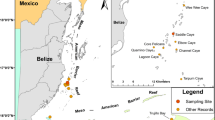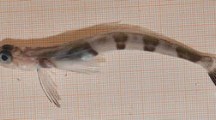Abstract
The gray rockcod Lepidonotothen squamifrons is widespread throughout the Antarctic region; however, little is known about its early life information. Highly abundant gray rockcod larvae were collected in the Amundsen Sea polynyas during a zooplankton survey conducted in March 2022. This is the first record of gray rockcod larvae in high abundance found at high latitudes in the Southern Ocean. The otolith microstructure analysis provided more insight into the early life characteristics of gray rockcod. A total of 41 individuals with a standard length of 9.6–15.3 mm were estimated to be 6–11 days. Multiple primordia were recorded in the otolith for the first time. The Gompertz model was well fitted to the age–length data, indicating a mean daily growth rate of 0.66 mm day−1 (SE = 0.35). Larval hatching occurred at a size of 4.08 mm (SE = 3.85) and was concentrated over a short period in early March. Compared to the populations observed at lower latitudes, the gray rockcod in the Amundsen Sea polynyas showed later hatch times, smaller hatch sizes, and faster growth rates. Therefore, we speculate that Amundsen Sea polynyas are potential spawning grounds for gray rockcod. The spatial differences in early life characteristics revealed herein could contribute to our understanding of the life history strategy and adaptation of the gray rockcod.





Similar content being viewed by others
References
Ainley DG, Blight LK (2009) Ecological repercussions of historical fish extraction from the Southern Ocean. Fish Fish 10(1):13–38. https://doi.org/10.1111/j.1467-2979.2008.00293.x
Alderkamp A-C, van Dijken GL, Lowry KE, Connelly TL, Lagerström M, Sherrell RM, Haskins C, Rogalsky E, Schofield O, Stammerjohn SE, Yager PL, Arrigo KR, Deming JW, Tremblay J-É (2015) Fe availability drives phytoplankton photosynthesis rates during spring bloom in the Amundsen Sea Polynya, Antarctica. Elementa. https://doi.org/10.12952/journal.elementa.000043
Arrigo KR (2003) Phytoplankton dynamics within 37 Antarctic coastal polynya systems. J Geophys Res. https://doi.org/10.1029/2002jc001739
Arrigo KR, Alderkamp A-C (2012) Shedding dynamic light on Fe limitation (DynaLiFe). Deep sea research part II topical studies in oceanography. Elsevier, Amsterdam. https://doi.org/10.1016/j.dsr2.2012.03.004
CCAMLR (1989) Schedule of Conservation Measures in Force CCAMLR
CCAMLR (2004) Report of the Thirteen Meeting of the Scientific Committee CCAMLR, Australia
Damerau M, Matschiner M, Salzburger W, Hanel R (2012) Comparative population genetics of seven notothenioid fish species reveals high levels of gene flow along ocean currents in the southern Scotia Arc Antarctica. Polar Biol 35(7):1073–1086. https://doi.org/10.1007/s00300-012-1155-x
Duan M, Zhang C, Liu Y, Ye Z, Liu C, Tian Y, He J (2022a) Early-life history traits of two icefishes, spiny icefish Chaenodraco wilsoni and ocellated icefish Chionodraco rastrospinosus, in the Ross Sea revealed by otolith microstructure. Polar Biol 45(3):427–436. https://doi.org/10.1007/s00300-021-03002-3
Duan M, Zhang C, Liu Y, Ye Z, Yang J, Liu C, Tian Y (2022b) Growth and early life stage of Antarctic silverfish (Pleuragramma antarctica) in the Amundsen Sea of the Southern Ocean: evidence for a potential new spawning/nursery ground. Polar Biol 45(2):359–368. https://doi.org/10.1007/s00300-021-02994-2
Duhamel G (1981) Caractéristiques biologiques des principales espèces de poissons du plateau continental des Îles Kerguelen. Cybium 5(1):19–32
Duhamel G, Ozouf-costaz C (1985) Age, growth and reproductive biology of Notothenia squamifrons Gunther, 1880 from the Indian sector of the Southern Ocean. Polar Biol 4(3):143–153. https://doi.org/10.1007/BF00263877
Duhamel G, Pruvost P, Bertignac M, Gasco N, Hautecoeur M (2011) Major fishery events in Kerguelen Islands: Notothenia rossii, Champsocephalus gunnari, Dissostichus eleginoides—Current distribution and status of stocks. In: Duhamel G, Welsford D (eds) The Kerguelen plateau: marine ecosystem and fisheries. Société Française d’Ichtyologie, Paris, pp 271–282
Duhamel G, Hulley PA, Causse R, Koubbi P, Vacchi M, Pruvost P, Vigetta S, IrissonJ O, Mormède S, Belchier M, Abellan LJL, VDPA P (2014) Biogeographic Patterns of Fish. In: De Broyer C et al (eds) Biogeographic Atlas of the Southern Ocean. Scientific Committee on Antarctic Research, Cambridge, pp 328–362
Fragoso GM, Smith WO (2012) Influence of hydrography on phytoplankton distribution in the Amundsen and Ross Seas, Antarctica. J Mar Syst 89(1):19–29. https://doi.org/10.1016/j.jmarsys.2011.07.008
Granata A, Cubeta A, Guglielmo L, Sidoti O, Greco S, Vacchi M, La Mesa M (2002) Ichthyoplankton abundance and distribution in the Ross Sea during 1987–1996. Polar Biol 25(3):187–202. https://doi.org/10.1007/s00300-001-0326-y
Gregory S, Brown J, Belchier M (2013) Ecology and distribution of the grey notothen, Lepidonotothen squamifrons, around South Georgia and Shag Rocks, Southern Ocean. Antarct Sci 26(3):239–249. https://doi.org/10.1017/s0954102013000667
Jiang Y, Liu Q, Yang EJ, Wang M, Kim Tae W, Cho K-H, Lee S (2016) Pelagic ciliate communities within the Amundsen Sea polynya and adjacent sea ice zone, Antarctica. Deep Sea Research Part II Topical Studies in Oceanography, vol 123. Elsevier, Amsterdam, pp 69–77. https://doi.org/10.1016/j.dsr2.2015.04.015
Jones CD, Eric Anderson M, Balushkin AV, Duhamel G, Eakin RR, Eastman JT, Kuhn KL, Lecointre G, Near TJ, North AW, Stein DL, Vacchi M, William Detrich H (2008) Diversity, relative abundance, new locality records and population structure of Antarctic demersal fishes from the northern Scotia Arc islands and Bouvetøya. Polar Biol 31(12):1481–1497. https://doi.org/10.1007/s00300-008-0489-x
Kellermann AK (1990) Identification key and catalogue of larval Antarctic fishes. Berichte zur Polarforschung (Reports on Polar Research), vol 67. Alfred-Wegener-Institut, Helmholtz-Zentrum für Polar- und Meeresforschung, Bremerhaven
Kellermann AK, Gauldie R, Ruzicka JJ (2002) Otolith microincrements in the Antarctic fishes Notothenia coriiceps and Pseudochaenichthys georgianus. Polar Biol 25(11):799–807. https://doi.org/10.1007/s00300-002-0432-5
Kock KH (1992) Antarctic Fish and Fisheries. Cambridge University Press
Koubbi P, Duhamel G, Camus P (1990) Early life stages of Notothenioidei from the Kerguelen Islands. Cybium 14:225–250
Koubbi P, Duhamel G, Hebert C (2000) Role of bay, fjord and seamount on the early life history of Lepidonotothen squamifrons from the Kerguelen Islands. Polar Biol 23(7):459–465. https://doi.org/10.1007/s003009900106
La Mesa M, Riginella E, Catalano B, Jones CD, Mazzoldi C (2017) Maternal contribution to spawning and early life-history strategies of the genus Lepidonotothen (Nototheniidae, Perciformes) along the southern Scotia Arc. Polar Biol 40(7):1441–1450. https://doi.org/10.1007/s00300-016-2068-x
La Mesa M, Llompart F, Riginella E, Eastman JT (2020) Parental care and reproductive strategies in notothenioid fishes. Fish Fish 22(2):356–376. https://doi.org/10.1111/faf.12523
Massom RA, Stammerjohn SE (2010) Antarctic sea ice change and variability—Physical and ecological implications. Polar Sci 4(2):149–186. https://doi.org/10.1016/j.polar.2010.05.001
Matallanas J, Olaso I (2006) Fishes of the Bellingshausen sea and Peter I Island. Polar Biol 30(3):333–341. https://doi.org/10.1007/s00300-006-0189-3
Miya T, Gon O, Mwale M, Poulin E (2016) Molecular systematics and taxonomic status of three latitudinally widespread nototheniid (Perciformes: Notothenioidei) fishes from the Southern Ocean. Zootaxa 4061(4):381–396. https://doi.org/10.11646/zootaxa.4061.4.4
Radtke RL, Hubold G, Folsom SD, Lenz PH (1993) Otolith structural and chemical analyses: the key to resolving age and growth of the Antarctic silverfish Pleuragramma Antarcticum. Antarct Sci 5(1):51–62. https://doi.org/10.1017/S0954102093000082
Yager P, Sherrell R, Stammerjohn S, Alderkamp A-C, Schofield O, Abrahamsen P, Arrigo K, Bertilsson S, Garay L, Guerrero R, Lowry K, Moksnes P-O, Ndungo K, Post A, Randall-Goodwin E, Riemann L, Severmann S, Thatje S, van Dijken G, Wilson S (2012) ASPIRE: The Amundsen Sea Polynya International Research Expedition. Oceanography 25(3):40–53. https://doi.org/10.5670/oceanog.2012.73
Acknowledgements
We are grateful to the scientific staff and the crew aboard the 37th Chinese National Antarctica Research Expeditions for their support in sampling processing and data collection. This study was financially supported by the research project “Impact and Response of Antarctic Seas to Climate Change, IRASCC2020-2022” (Grant No. IRASCC 01-02-05C) from the Chinese Arctic and Antarctic Administration (CAA), Ministry of Natural Resources of the People’s Republic of China.
Author information
Authors and Affiliations
Contributions
HG conducted the experiments, analyzed the data and wrote the manuscript. CZ conducted the experiments and edited the manuscript. MD assisted sample processing. JL and WZ collected the fish samples. YT designed and reviewed the manuscript. All authors read and approved the final manuscript.
Corresponding author
Ethics declarations
Conflict of interest
The authors declare that they have no conflicts of interest and that all applicable institutional, national, or international guidelines for the use and care of animals were strictly followed in the present study.
Additional information
Publisher's Note
Springer Nature remains neutral with regard to jurisdictional claims in published maps and institutional affiliations.
Supplementary Information
Below is the link to the electronic supplementary material.
Rights and permissions
Springer Nature or its licensor (e.g. a society or other partner) holds exclusive rights to this article under a publishing agreement with the author(s) or other rightsholder(s); author self-archiving of the accepted manuscript version of this article is solely governed by the terms of such publishing agreement and applicable law.
About this article
Cite this article
Guo, H., Zhang, C., Duan, M. et al. First record of gray rockcod Lepidonotothen squamifrons larvae in the Amundsen Sea, Antarctic: implication for a new spawning ground and early life characteristics. Polar Biol 46, 133–138 (2023). https://doi.org/10.1007/s00300-022-03111-7
Received:
Revised:
Accepted:
Published:
Issue Date:
DOI: https://doi.org/10.1007/s00300-022-03111-7




